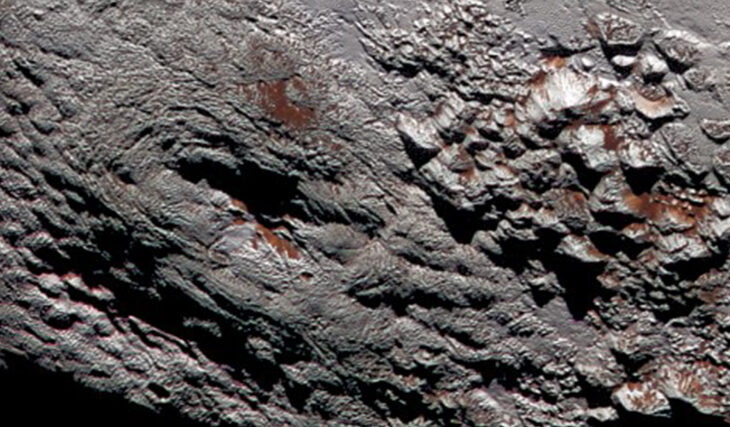In 2015, scientists learned that there is a giant red “whale” on Pluto. This dark-colored area could signify a massive impact – the same one that produced Pluto’s huge moon Charon. “The Whale” extends over 1,900 miles (3,000 km).
The New Horizons interplanetary station transmitted the first color photograph of Pluto and Charon to Earth. The image was taken on April 9, 2015, from a distance of 115 million kilometers.
Mercator projection map of Pluto’s image was taken by the New Horizons spacecraft. The dotted curve on the lower panel schematically represents the dark and reddish whale-shaped region (Cthulhu Regio). Credit: NASA/APL.
Why is the whale red?
Scientists have suggested that the reddish color of the dark area may be due to tholins, which are complex hydrocarbons. But how did they form there?
Shokin Yasuhito, an assistant professor at the University of Tokyo, conducted research in which he heated organic compounds such as formaldehyde. These compounds were present on Pluto during the early period after the formation of the Solar System. Through experiments in which solutions were heated to 122 degrees Fahrenheit (50 degrees Celsius) over several months, Sekine could reproduce the dark reddish hue.
At the same time, Hidenori Genda, an assistant professor at the Tokyo Institute of Technology, was conducting computer simulations of a collision that could occur with Pluto. Genda concluded that an impact similar to the one that led to the formation of Pluto’s moon, Charon, could have caused the formation of a massive pool of hot water near Pluto’s equator. As this pool cooled, reddish complex organic matter may have formed.
Heart of Pluto
The New Horizons spacecraft also photographed the “Heart of Pluto,” known as “Tombaugh’s Region.” This zone, with a diameter of approximately 2,300 kilometers, stands out for its light color. More detailed images of Pluto show that the two sides of this “heart” shape are different: the left side, where Sputnik Planum is located, appears brighter. This left part is believed to be a crater filled with crystalline nitrogen and may be found at a higher level than the rest of this light zone.
Composite, enhanced-color image of Pluto (lower right) and its largest moon Charon (upper left), taken by NASA’s New Horizons spacecraft on July 14, 2015. Pluto and Charon are shown with approximately correct relative sizes, but their true separation is not to scale. Credit: NASA/JHUAPL/SwRI
Since 1990, it has been spring on Pluto. In 2178, Pluto will complete a full orbit around the Sun for the first time since its discovery.
Banner image: Composite image of Wright Mons, one of two potential cryovolcanoes spotted on the surface of Pluto by the New Horizons spacecraft in July 2015. Credit: NASA/JHUAPL/SwRI.
Image credit:
https://www.nasa.gov
https://www.natureasia.com
https://www.nasa.gov
